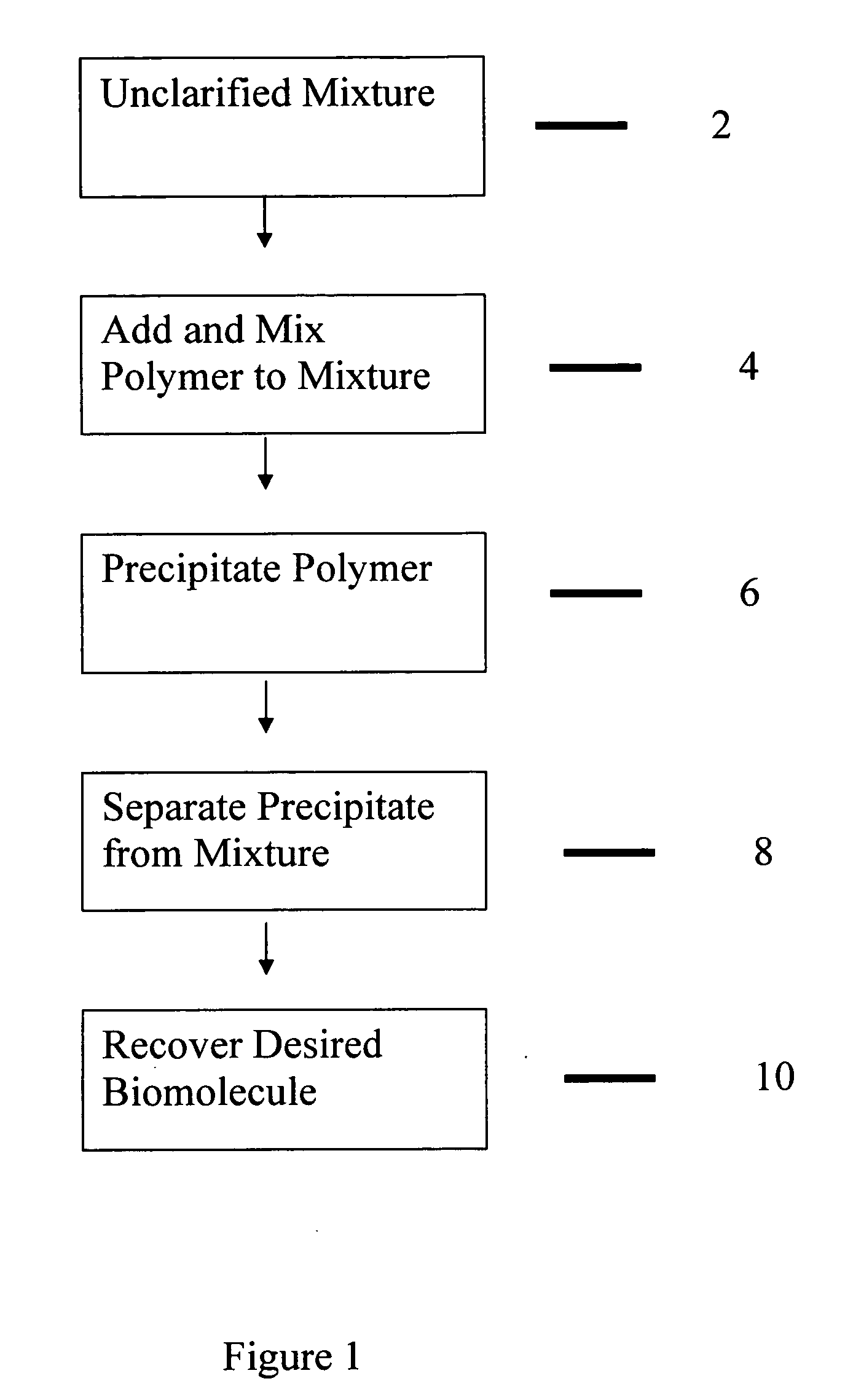Purification of proteins
a technology of protein and purification process, which is applied in the direction of immunoglobulins against animals/humans, peptides, enzymology, etc., can solve the problems of difficult prediction of the exact level of impurities in the broth, inability to remove excess polyelectrolyte, etc., to achieve the effect of enhancing the uf (charged uf) process
- Summary
- Abstract
- Description
- Claims
- Application Information
AI Technical Summary
Benefits of technology
Problems solved by technology
Method used
Image
Examples
example 1
pH Adjustment of an Unclarified Cell Culture Fluid
[0136]Cells derived from a non-expressing Chinese Hamster Ovary (CHO) cell line were grown in a bioreactor (New Brunswick Scientific) to a density of 2×106 cells / ml in 10 L of culture medium and harvested at 64% viability. IgG was spiked to a concentration of 0.8 g / L and the concentrations of host cell proteins (HCP) was 4075 ng / ml. The pH of the fluid was 7.2. The pH of the unclarified cell culture fluid was adjusted to 4.5 using 0.5 ml of 1.0M HCl, prior to the start of the purification process.
example 2
This Example Illustrates the Removal of Residual 4-Vinyl Pyridine Monomer from Poly(4-Vinylpyridine)
[0137]Linear poly(4-vinylpyridine), (PVP) MW 200,000 obtained form Scientific Polymer Products, Inc., was spread evenly on a glass dish and placed in a vacuum oven. The atmosphere inside the oven was purged with argon for 5 minutes several times to remove oxygen. The pressure in the oven was reduced to 0.1 in mercury using a mechanical vacuum pump and subsequently the temperature was raised to 120° C. The polymer was subjected to these conditions for a total of 24 hours. During this time, the atmosphere inside the oven was purged with argon for 5 minutes several times. At the end of the heating period, the oven temperature was lowered to room temperature and the oven was purged with argon several times before opening the door. The resulting polymer did not have a noticeable odor, whereas the untreated polymer has a distinct odor of 4-vinyl pyridine monomer. The amount of residual 4-vi...
example 3
This Example Illustrates the Synthesis of Quaternized Poly(4-Vinyl Pyridine), QPVP
[0138]PVP was purified as described in example 2. Iodoethane, Dimethylformamide and toluene were obtained from Sigma and used as received.
[0139]A solution of 5 g (0.047 mol based on monomer repeat unit) of PVP, 2.6 g (0.016 mol) of Iodoethane in 30 ml of DMF was maintained at T=80° C. for 12 hr under a nitrogen atmosphere. After cooling to room temperature, the polymer solution was precipitated in 200 ml toluene. The resulting solid was further washed with 100 ml toluene and then dried in an oven at 70° C. for 24 hr with a yield of 95%. The mole ratio of the reactants was selected such that the product comprises 35 mol % of quaternized pyridine rings.
PUM
| Property | Measurement | Unit |
|---|---|---|
| Fraction | aaaaa | aaaaa |
| Temperature | aaaaa | aaaaa |
| Fraction | aaaaa | aaaaa |
Abstract
Description
Claims
Application Information
 Login to View More
Login to View More - R&D
- Intellectual Property
- Life Sciences
- Materials
- Tech Scout
- Unparalleled Data Quality
- Higher Quality Content
- 60% Fewer Hallucinations
Browse by: Latest US Patents, China's latest patents, Technical Efficacy Thesaurus, Application Domain, Technology Topic, Popular Technical Reports.
© 2025 PatSnap. All rights reserved.Legal|Privacy policy|Modern Slavery Act Transparency Statement|Sitemap|About US| Contact US: help@patsnap.com

